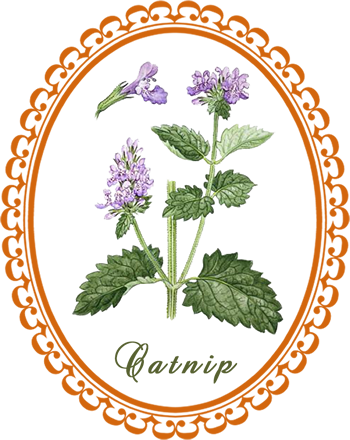
Catnip: traditionally used for the treatment of colds and flu, but also relaxing and calming properties. Especially suitable for children with fevers ...
Common Names: Catnip
Botanical Name: Nepeta cataria
Family: Lamiaceae
Plant Type: Perennial
Parts Used: Leaves and flowering tops
Flowering: July
Catnip originated in Europe where it has been used for centuries as a medicinal plant. It was known to Roman cooks and doctors and went with European settlers wherever they went. Catnip got its name from its well-known reputation for attracting cats. Cats are so delighted by the smell of catnip that they will roll on the plant and eat the branches and leaves. Catnip scent is said to drive mice away.
Description: Catnip is an erect perennial with square, branched, woolly stems. Leaves are heart shaped with grayish-green, downy undersides and toothed edges. Flowers are tubular, white with purple-pink spots, and are arranged in dense whorls on spikes.
Cultivation: Catnip is a hardy perennial which does not grow easily from seed, but from cuttings. Divide mature plants in spring or autumn; or take cuttings in early summer. Catnip likes dry, sandy, well-drained soil, in sun to part shade, with a pH of 6.6. It is hardy to zone 3.
Harvesting: Pick flowering tops in late summer; leaves any time. Use fresh or dry.
Catnip Magick
Animal Magick. Beauty. Happiness. Love.
Gender: Feminine
Planet: Venus
Element: Water
Diety: Bast
Use with rose petals in love sachets.
Catnip enhances beauty and happiness.
Press large catnip leaves and use them as bookmarks in your magical books.
Give to your cat to create a psychic bond with it (or at least intoxicate your cat...)
Grow it near your home or hang it over your door to attract good spirits and great luck.
Herbal Healing with Catnip
Medicinal Actions: Anti-spasmodic, astringent, carminative, diaphoretic, sedative
Medicinal Uses: Catnip tea is used to treat everything from colds to cancer. Common uses are: as a digestive tonic and mild sleeping aid. Catnip eases upset stomachs. It is good for treating children's diarrhea.
Body Care with Catnip
- To ease away tension headaches, anxiety or insomnia, take 1 cup catnip infusion up to three times daily.
- To soothe stress-related indigestion, take 1 teaspoon catnip tincture up to three times daily, as required.
- To reduce fluid retention in the legs, apply a catnip leaf poultice to the affected area every morning and evening until the swelling is reduced.
Tincture: 200g (7 oz) dried or 400g (14 oz) fresh catnip flowering tops or leaves in 1 litre (4 cups) vodka-water mix.
Poultice: Add very hot water to herb powder to make a paste, or simmer sufficient chopped fresh or dried herb to cover the area in a little water for 2 minutes, then squeeze out the water. Spread the powder or fresh-herb paste over your skin as hot as you can tolerate and bandage it in place with gauze. Leave it there for two to three hours, then repeat if necessary.
Source: The Essential Herbs Handbook by Lesley Bremness
If you appreciate the information provided,
please help keep this website running. Blessings!
© 2008-2025 aromaworx.ca. All rights reserved.

